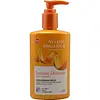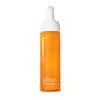What's inside
What's inside
 Key Ingredients
Key Ingredients

 Benefits
Benefits

 Concerns
Concerns

 Ingredients Side-by-side
Ingredients Side-by-side

Aloe Barbadensis Leaf Juice
Skin ConditioningWater
Skin ConditioningStearic Acid
CleansingGlycerin
HumectantGlyceryl Stearate Se
EmulsifyingCetearyl Alcohol
EmollientCetyl Alcohol
EmollientHelianthus Annuus Seed Oil
EmollientCaprylic/Capric Triglyceride
MaskingAleurites Moluccanus Seed Oil
Skin ConditioningBorago Officinalis Seed Oil
EmollientButyrospermum Parkii Butter
Skin ConditioningCitrus Aurantium Bergamia Fruit Oil
MaskingCitrus Aurantium Dulcis Peel Oil
MaskingCitrus Limon Peel Oil
MaskingArnica Montana Flower Extract
MaskingCamellia Sinensis Leaf Extract
AntimicrobialChamomilla Recutita Flower Extract
MaskingCitrus Limon Peel Extract
EmollientLaminaria Digitata Extract
Skin ProtectingLavandula Angustifolia Flower/Leaf/Stem Extract
MaskingLinum Usitatissimum Seed Extract
PerfumingOlea Europaea Leaf Extract
PerfumingAscorbic Acid
AntioxidantAscorbyl Glucoside
AntioxidantCetearyl Glucoside
EmulsifyingTocopheryl Acetate
AntioxidantXanthan Gum
EmulsifyingAlcohol
AntimicrobialBenzyl Alcohol
PerfumingPotassium Hydroxide
BufferingPotassium Sorbate
PreservativeSodium Benzoate
MaskingLimonene
PerfumingAloe Barbadensis Leaf Juice, Water, Stearic Acid, Glycerin, Glyceryl Stearate Se, Cetearyl Alcohol, Cetyl Alcohol, Helianthus Annuus Seed Oil, Caprylic/Capric Triglyceride, Aleurites Moluccanus Seed Oil, Borago Officinalis Seed Oil, Butyrospermum Parkii Butter, Citrus Aurantium Bergamia Fruit Oil, Citrus Aurantium Dulcis Peel Oil, Citrus Limon Peel Oil, Arnica Montana Flower Extract, Camellia Sinensis Leaf Extract, Chamomilla Recutita Flower Extract, Citrus Limon Peel Extract, Laminaria Digitata Extract, Lavandula Angustifolia Flower/Leaf/Stem Extract, Linum Usitatissimum Seed Extract, Olea Europaea Leaf Extract, Ascorbic Acid, Ascorbyl Glucoside, Cetearyl Glucoside, Tocopheryl Acetate, Xanthan Gum, Alcohol, Benzyl Alcohol, Potassium Hydroxide, Potassium Sorbate, Sodium Benzoate, Limonene
Water
Skin ConditioningSodium Methyl Cocoyl Taurate
CleansingCocamidopropyl Betaine
CleansingPPG-5-Ceteth-20
EmulsifyingParfum
MaskingCocamidopropyl Pg-Dimonium Chloride Phosphate
PEG-8 Dimethicone
EmulsifyingPhenoxyethanol
PreservativePEG-8 Ricinoleate
Leuconostoc/Radish Root Ferment Filtrate
AntimicrobialCitric Acid
BufferingAscorbic Acid
AntioxidantAloe Barbadensis Leaf Juice
Skin ConditioningGlycerin
HumectantCalcium Ascorbate
AntioxidantCucurbita Pepo Fruit Extract
Skin ConditioningChamomilla Recutita Flower Extract
MaskingAspalathus Linearis Leaf Extract
Skin ConditioningRibes Nigrum Seed Oil
EmollientLinum Usitatissimum Seed Oil
PerfumingDaucus Carota Sativa Seed Oil
EmollientBorago Officinalis Seed Oil
EmollientButyrospermum Parkii Butter
Skin ConditioningSodium Benzoate
MaskingPotassium Sorbate
PreservativeSodium Sulfite
PreservativeLimonene
PerfumingWater, Sodium Methyl Cocoyl Taurate, Cocamidopropyl Betaine, PPG-5-Ceteth-20, Parfum, Cocamidopropyl Pg-Dimonium Chloride Phosphate, PEG-8 Dimethicone, Phenoxyethanol, PEG-8 Ricinoleate, Leuconostoc/Radish Root Ferment Filtrate, Citric Acid, Ascorbic Acid, Aloe Barbadensis Leaf Juice, Glycerin, Calcium Ascorbate, Cucurbita Pepo Fruit Extract, Chamomilla Recutita Flower Extract, Aspalathus Linearis Leaf Extract, Ribes Nigrum Seed Oil, Linum Usitatissimum Seed Oil, Daucus Carota Sativa Seed Oil, Borago Officinalis Seed Oil, Butyrospermum Parkii Butter, Sodium Benzoate, Potassium Sorbate, Sodium Sulfite, Limonene
Ingredients Explained
These ingredients are found in both products.
Ingredients higher up in an ingredient list are typically present in a larger amount.
Aloe Barbadensis Leaf Juice comes from leaves of the aloe plant. Aloe Barbadensis Leaf Juice is best known for helping to soothe sunburns. It is also anti-inflammatory, moisturizing, antiseptic, and can help heal wounds.
Aloe is packed with good stuff including Vitamins A, C, and E. These vitamins are antioxidants, which help fight free-radicals and the damage they may cause. Free-radicals are molecules that may damage your skin cells, such as pollution.
Aloe Barbadensis Leaf Juice also contains sugars. These sugars come in the form of monosaccharides and polysaccharides, folic acid, and choline. These sugars are able to help bind moisture to skin.
It also contains minerals such as calcium, 12 anthraquinones, fatty acids, amino acids, and Vitamin B12.
Learn more about Aloe Barbadensis Leaf JuiceAscorbic Acid is is pure Vitamin C. This form makes up the largest amount of vitamin C found naturally in our skin.
Not only is vitamin C great for your overall health and immune system, it also has plenty of benefits on your skin.
Vitamin C is best used for brightening skin. It improves dark spots, acne scars, and hyperpigmentation. This is because it blocks the process of skin darkening when exposed to UV.
Remember: Vitamin C should not replace sunscreen!
Your skin uses vitamin C to build collagen. Collagen is one key component in having a strong skin barrier and plump skin. Vitamin C also plays a role in regulating collagen, thus making it effective in improving wrinkles and fine lines.
Ascorbic acid shows potent antioxidant activity. As an antioxidant, it helps fight free-radicals. Free-radicals are molecules that may damage your skin cells. These antioxidants also protect skin against UV damage.
The best formulations include Vitamin E and/or ferulic acid. These two ingredients help stabilize and provide a boost in the benefits of ascorbic acid. This is because ascorbic acid becomes unstable when exposed to UV and air. In fact, you can tell your ascorbic acid has oxidized when it turns an orange-yellow color.
Ascorbic acid is generally compatible with other ingredients. However, using ascorbic acid with other active ingredients might cause irritation. Two ingredients: copper ions and benzoyl peroxide, will inactivate ascorbic acid completely.
Read more about other types of Vitamin C:
Foods rich with vitamin C include oranges, strawberries, broccoli, bell peppers, and more. When consuming Vitamin C, your skin receives a portion of the nutrients.
Learn more about Ascorbic AcidBorago Officinalis Seed Oil is from the seeds of the starflower plant. This plant grows primarily in Europe.
This oil does not have a scent. It contains fatty acids such as linolenic acid. These fatty acids help keep skin hydrated.
Borago Officinalis Seed Oil is an antioxidant. Antioxidants help fight free-radicals. Free-radicals are molecules that may damage your skin cells.
Learn more about Borago Officinalis Seed OilThis ingredient is also known as shea butter. It is an effective skin hydrator and emollient.
Emollients help soothe and soften your skin. It does this by creating a protective film on your skin. This barrier helps trap moisture and keeps your skin hydrated. Emollients may be effective at treating dry or itchy skin.
Shea butter is rich in antioxidants. Antioxidants help fight free-radicals, or molecules that may harm the body. It is also full of fatty acids including stearic acid and linoleic acid. These acids help replenish the skin and keep skin moisturized.
While Shea Butter has an SPF rating of about 3-4, it is not a sunscreen replacement.
Shea butter may not be fungal acne safe. We recommend speaking with a professional if you have any concerns.
Learn more about Butyrospermum Parkii ButterChamomilla Recutita Flower Extract comes from the Chamomile flower.
Chamomile is rich in antioxidants and has anti-inflammatory properties. Several compounds found in chamomile help with soothing, such as bisbolol.
Antioxidant components in chamomile make it an effective ingredient to help slow the signs of aging. Antioxidants help fight free-radical molecules, or molecules that may damage your skin.
Essential oils from chamomile have been found to improve wound healing due to its antimicrobial properties.
Ancient Greeks and Egyptians used Chamomile to treat skin redness and dryness. Chamomile has also been used to help treat stomach issues.
Learn more about Chamomilla Recutita Flower ExtractGlycerin is already naturally found in your skin. It helps moisturize and protect your skin.
A study from 2016 found glycerin to be more effective as a humectant than AHAs and hyaluronic acid.
As a humectant, it helps the skin stay hydrated by pulling moisture to your skin. The low molecular weight of glycerin allows it to pull moisture into the deeper layers of your skin.
Hydrated skin improves your skin barrier; Your skin barrier helps protect against irritants and bacteria.
Glycerin has also been found to have antimicrobial and antiviral properties. Due to these properties, glycerin is often used in wound and burn treatments.
In cosmetics, glycerin is usually derived from plants such as soybean or palm. However, it can also be sourced from animals, such as tallow or animal fat.
This ingredient is organic, colorless, odorless, and non-toxic.
Glycerin is the name for this ingredient in American English. British English uses Glycerol/Glycerine.
Learn more about GlycerinLimonene is a fragrance that adds scent and taste to a formulation.
It's found in the peel oil of citrus fruits and other plants such as lavender and eucalyptus. The scent of limonene is generally described as "sweet citrus".
Limonene acts as an antioxidant, meaning it helps neutralize free radicals.
When exposed to air, oxidized limonene may sensitize the skin. Because of this, limonene is often avoided by people with sensitive skin.
The term 'fragrance' is not regulated in many countries. In many cases, it is up to the brand to define this term. For instance, many brands choose to label themselves as "fragrance-free" because they are not using synthetic fragrances. However, their products may still contain ingredients such as essential oils that are considered a fragrance.
Learn more about LimonenePotassium Sorbate is a preservative used to prevent yeast and mold in products. It is commonly found in both cosmetic and food products.
This ingredient comes from potassium salt derived from sorbic acid. Sorbic acid is a natural antibiotic and effective against fungus.
Both potassium sorbate and sorbic acid can be found in baked goods, cheeses, dried meats, dried fruit, ice cream, pickles, wine, yogurt, and more.
You'll often find this ingredient used with other preservatives.
Learn more about Potassium SorbateSodium Benzoate is a preservative. It's used in both cosmetic and food products to inhibit the growth of mold and bacteria. It is typically produced synthetically.
Both the US FDA and EU Health Committee have approved the use of sodium benzoate. In the US, levels of 0.1% (of the total product) are allowed.
Sodium benzoate works as a preservative by inhibiting the growth of bacteria inside of cells. It prevents the cell from fermenting a type of sugar using an enzyme called phosphofructokinase.
It is the salt of benzoic acid. Foods containing sodium benzoate include soda, salad dressings, condiments, fruit juices, wines, and snack foods.
Studies for using ascorbic acid and sodium benzoate in cosmetics are lacking, especially in skincare routines with multiple steps.
We always recommend speaking with a professional, such as a dermatologist, if you have any concerns.
Learn more about Sodium BenzoateWater. It's the most common cosmetic ingredient of all. You'll usually see it at the top of ingredient lists, meaning that it makes up the largest part of the product.
So why is it so popular? Water most often acts as a solvent - this means that it helps dissolve other ingredients into the formulation.
You'll also recognize water as that liquid we all need to stay alive. If you see this, drink a glass of water. Stay hydrated!
Learn more about Water